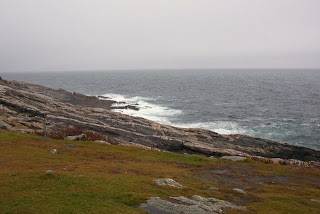I used to work at an ad agency in Manhattan, and the first client assigned to me was G.H. Bass & Co. At the time, they were headquartered in South Portland, Maine, and they had just opened 3 Spirit of Maine retail shops. Lucky for me, I've got Maine in my genes and have never loved any place more than I love Maine so it was easy for me to create concepts and copy for Bass. I'm going to include below an article I wrote for their newsletter on Pemaquid Light and the Pemaquid Peninsula.
Pemaquid Point Light Captures the Spirit of Maine
Imagine a picturesque lighthouse sitting high atop a rocky point, the surf crashing ceaselessly below, a vast expanse of ocean stretching beyond. This breathtaking scene can be found on the coast of Maine at Pemaquid Point, located at the end of Route 130 on the western side of Muscongus Bay.
Pemaquid Point Light, a favorite of photographers and artists, sits 79 feet above the water, perched on a ledge of striated volcanic rock. The exceptionally pretty lighthouse looks most impressive when viewed from the rocks below. Stop by on a summer’s day, and you’ll find adults and children alike climbing the rocks for hours on end, enjoying the views of the spectacular lighthouse and the pounding sea.
Rocky Cliffs Contain Unexpected Beauty
One of the joys of exploring Pemaquid Point is the chance to investigate the multicolored tidal pools found within the crevices of rock. Any visitor who takes a moment for a closer look at a tidal pool will be fascinated by all manner of marine life, from seaweed to tiny snails and sea urchins.
Next to Pemaquid Point Light is the keeper’s house, now converted to the Fishermen’s Museum. Individuals interested in Maine’s maritime history will enjoy viewing the fine photographs, ship models, and other artifacts on Maine lighthouses and the fishing industry on display here. Nearby is the Pemaquid Art Gallery, where local artists exhibit their works from June through mid-September. Picnic tables and the Sea Gull Shop and Restaurant are next door.
Step Back in Time
Another interesting spot on the Pemaquid peninsula is the Colonial Pemaquid State Historic Site. The Pemaquid area has a long history, and a visit to this archaeological site gives one the opportunity to step back in time. In the early 1800s, farmers filled in the cellar holes of the 17th-century settlement that once stood on this spot. Led by a Rutgers professor, excavations were begun in recent years to uncover the village’s remains. Today, the foundations of homes, a custom house, a tavern, and a jail are visible.
An archaeological museum now holds the many artifacts unearthed from Maine’s “lost city,” such as tools, jugs, pottery, and wampum. It is one of the few in-the-field archaeological museums open to the public anywhere. Here, dioramas depict an earlier village, giving visitors an idea of how the original 1620s settlement looked.
Next to the archaeological museum stands Fort William Henry, a replica of a structure built in 1689 to fend off pirates and the French, which contains exhibits on the early explorations of Maine. A nearby burial ground dates back to 1695. Visitors often wander through the cemetery, looking at the headstones that bear messages both amusing and poignant, wondering about the people who populated the peninsula in bygone days. One thing is certain: Pemaquid’s rugged beauty is as evident today as it was 300 years ago.






















No comments:
Post a Comment